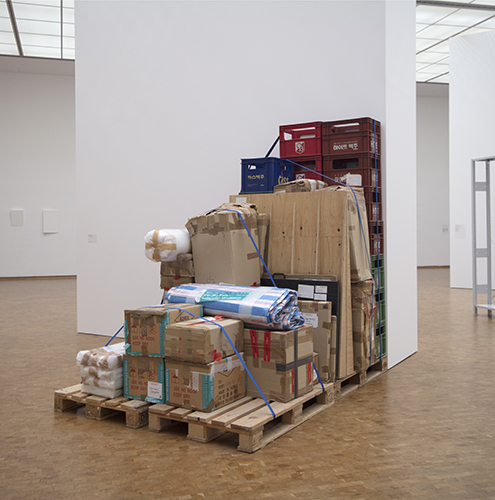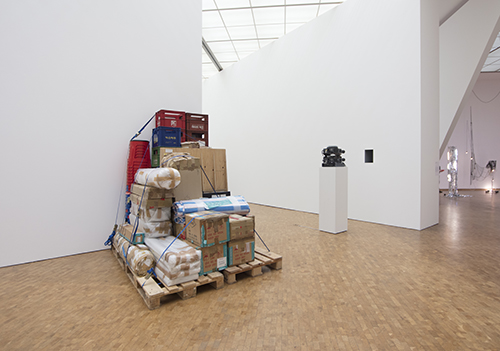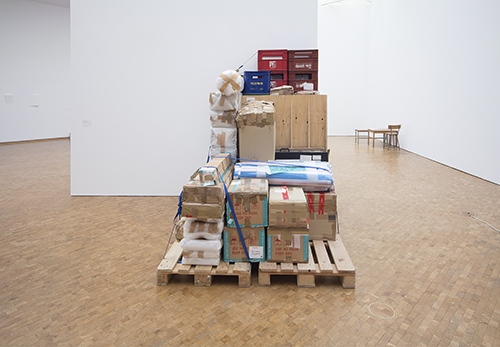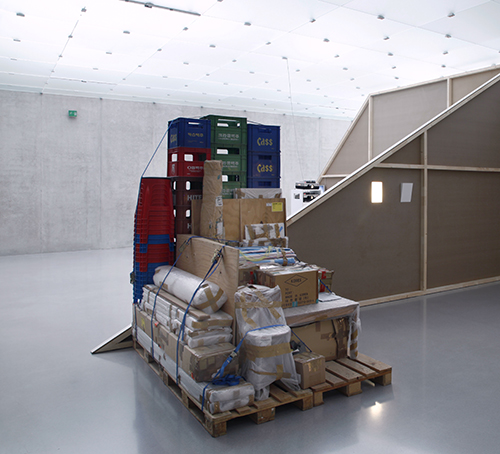Storage Piece
2004
Wrapped and stacked artworks, europallets
Dimensions variable
Haubrok Collection, Berlin
Installation view of Haegue Yang: ETA 1994–2018. 2018 Wolfgang Hahn Prize, Museum Ludwig, Cologne, 2018
Photo: Studio Haegue Yang



Installation view of Arrivals, Kunsthaus Bregenz, Bregenz, Austria, 2011
Photo: Markus Tretter



Installation view of Alterity Display, Lawrence O’Hana Gallery, London, UK, 2004
Photo: Lawrence O’Hana Gallery

Installation view of Kasse, Shop, Kino und Weiteres, Landesmuseum, Darmstadt, Germany, 2004
Photo: Wolfgang Fuhrmannek
Speech for Storage Piece
2004
Performance and recording, 1 local actor, ca. 10 min, sound system
Installation view of Your Bright Future: 12 Contemporary Artists from Korea, LACMA, Los Angeles, USA, 2009
Photo © 2009 Museum Associates/LACMA

Installation view of If I can’t dance, I don’t want to be part of your Revolution, Episode II: Feminist Legacies and Potentials in Contemporary Practice, De Appel, Amsterdam, Netherlands, 2006
Photo: Sal Kroonenberg


Interview with Haegue Yang and Binna Choi
Newsletter of BAK, basis voor actuele kunst, Utrecht, March 2006
Storage Piece originated from a deficiency in the artist’s space while participating in a residency program in London. Lacking a storage space, the artist collected all of the pieces returned after different exhibitions and titled it Storage Piece. Arranged neatly on top of four standardized wooden pallets just as they were packaged by the shipping companies, it is a rechristening of 13 of Yang’s earlier works. Since its debut in the UK, Storage Piece has been shown in Darmstadt, Berlin, São Paulo, Amsterdam, Hanover and Bregenz. At the 2007 exhibition Unpacking Storage Piece at the Haubrokshows in Berlin, the various works stored in the piece were unpacked and displayed in a new form. It has also been shown in a gradual process of being unpacked at exhibitions in Los Angeles, Houston, and other locations. In this way, Storage Piece hints at the various conditions and fates of an artwork from its creative reconstruction, the exhibition practice, to the problems of storage and selling. Meanwhile, Speech for Storage Piece — also presented here—gives life to the content and context of individual works of art that are not immediately accessible. It provides information that cannot be gleaned from the packing slips stuck to the works (which reveal only the contents and volume of the works), inducing the viewer to confront the psychological contexts such as the artist’s beliefs, doubts, and concerns.
Storage Piece by Marina Vishmidt
Storage Piece (2004) has almost as many paradoxes wrapped into it as artworks. Faced with an exhibition invitation around the same time as other exhibitions were ending and works returning without the means to find storage space for their entirety the artist found one solution to both dilemmas. The works that could not be accommodated, and which she felt ambivalent about showing in any case, were professionally packaged and shipped off to the gallery to be shown in that condition—a congeries of wrapped objects unified on four europalettes. Old work became a new work, the exhibition space became a storage space, and these transformations went further still: The new work, if purchased, could be maintained as a new work and an old work at the same time, if it was unpacked into its components (a process to be negotiated between the artist and collector). Thus the ‘re-statement’ of old work into new work also started to look like a discount offering, a bulk buy, lampooning the prestige of its exhibition situation while taking advantage of it. The exhibition space was still exhibiting Storage Piece as an installation, even if the storage of invisible pieces was the sum of the work on display. With great and habitual precision, Yang displays a ‘conflicting situation,’ bringing out the implicit into debate. Does the artist show work because she has nowhere else to put it, and she is hoping it will sell? Is it necessary to present autonomous art objects in a gallery space to have a show; need the work be unwrapped, to adapt one of Sol LeWitt’s axioms (‘the work need not be made’)? By keeping the ‘work’ under wraps, she forces the question of where is the work and what is it which is offered for sale—is it the situation or its material residue? There is likewise the question of spectral value: the remediation of ‘surplus’ or waste into a new desirable object by subjecting it to a conceptual turn (and plenty of bubble wrap). It could almost be considered an allegory for a whole history of ‘de-materialization’ in art, and a reflection on the misunderstanding of materiality so crucial to that history.
The precursors of this work in Yang’s oeuvre, to the degree they can be found, are Tilting on a Plane (2002) and Adopting Proportion (2003). Both eventually ended up packaged in Storage Piece, and bear a taxonomic kinship to its mode of proceeding. Tilting on a Plane is eight plastic various beverage crates each stacked in two columns on a wedge-shaped piece of wood, reaching the maximum height they could have to avoid toppling over. Adopting Proportion shows a shift in how the artist approaches the role of the archive and the role of cultural specificity in her work, while invoking the problem of translation by using objects. Amounting to an array of ‘typical’ items on sale in Korea acquired there for her by a personal shopper, the piece reduces the valence of the exotic to ‘a vast collection of commodities’, as Marx defined the initial appearance of wealth in a capitalist society. It conflates the art market with the street market, as Storage Piece also brings high and low-value spaces in proximity through the intermediary of an organizing rule for objects. They are placed on the same level, and credibility cannot find rest at either pole. Adopting Proportion proposes that the tactic of representing a ‘homeland’ through photos or collages, despite their uptake of abstraction and seriality, has run out of steam. Now the ‘foreign matter’ is presented directly as if in a Wittgensteinian language game where the exchange of concepts becomes an exchange of physical objects; every time I say ‘red,’ I get handed an apple, and so forth. What especially this work and Storage Piece share (less so Tilting on a Plane, which is a more straightforward brush of the demotic against the high minimalist grain) is a reciprocity between language and object which is maddening and without end.
(Exerpt from Haegue Yang: Arrivals, Catalogue raisonné, edited by Yilmaz Dziewior with contributions by Anders Kreuger, Yilmaz Dziewior and commentaries on works by Marina Vishmidt, Walther König Buchandlung, Köln, 2015, pp. 181-183.)
Exhibition history
ETA 194-2018, Museum Ludwig, Cologne, Germany, 2018
Shooting the Elephant 象 Thinking the Elephant, Leeum, Samsung Museum of Art, Seoul, South Korea, 2015
Arrivals, Kunsthaus Bregenz, Bregenz, Austria, 2011
Your Bright Future: 12 Contemporary Artists from Korea, LACMA, Los Angeles, Museum of Fine Arts, Houston, USA, 2009
Unpacking Storage Piece, Haubrokshows, Berlin, Germany, 2007
Made in Germany, Kestnergesellschaft, Sprengel Museum and Kunstverein Hannover, Germany, 2007
If I can’t dance, I don’t want to be part of your Revolution, Episode II: Feminist Legacies and Potentials in Contemporary Practice, De Appel, Amsterdam, Netherlands, 2006
Como Viver Junto (How to Live Together), 27th Bienal de São Paulo, São Paulo, Brazil, 2006
Kasse, Shop, Kino und Weiteres, Landesmuseum, Darmstadt, Germany, 2004
Cork Caucus, Sculpture Factory, Cork, Ireland, 2005
Alterity Display, Lawrence O’Hana Gallery, London, UK, 2004
back to alphabetical order |
back to chronological order |